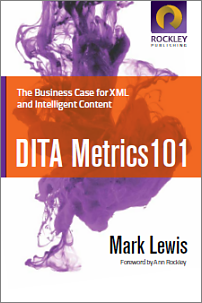ReviewsVal SwisherCEO - Content Rules, Inc. In her blog entry of May 5th, Val had just returned from speaking at the Society for Technical Communication Annual Conference. While there, she spoke to Mark, and then blogged about her reading of the book."By far, my favorite conversation of the conference was with Mark Lewis. Mark is a content strategist and DITA educator for Quark. He is also the author of the just-released book, "DITA Metrics 101 - The Business Case for XML and Intelligent Content," from Rockley Publishing (ISBN 978-0-9865233-4-2). I will be honest - since the book just came out and I just came back from a 2-week vacation, I have not read the whole thing. From the chapters I have read, I like the premise of the book and I think the topic is extremely important." and... "I have asked Mark to start thinking about how we might model some of these hidden [translation] costs. That way, we can further make the business case that intelligent content saves money on translation. And, I will add, clean, accurate, simple, and well-written source content (whether structured or not) also is a big part of a business case for translation savings. Thanks, Mark, for the very interesting chat!" You can read Val's full blog entry here. Michael BosesCo-chair, DITA for Enterprise Business Documents Subcommittee In DITA Metrics 101, Mark Lewis proves once again that he is the "go-to-guy" when it comes to bridging the gap between tech pubs departments looking for process improvement and busy executives who must understand the business case before allocating funds. Mark's insightful guidance couldn't have come at a better time. After a couple of decades of technical publications being what many organizations viewed as a "necessary evil," the Web 2.0 economy has potential consumers helping themselves to User Guides, technical literature, and the support section of your website to get the inside scoop on your product before they make a purchase. Lewis takes the practical path of demonstrating the Return on Investment (ROI) of the Darwin Information Typing Architecture (DITA) approach to more efficient development of technical content. He describes the process for quantifying the improvement, walks through step-by-step examples, and provides templates for developing a conservative projection of your own organization's expected savings. He speaks the language of technical publications experts and then helps the reader understand how to express the findings to a business audience. The reader should feel confident that the outcomes will stand up to the typically rigorous financial examination that any claim of ROI is bound to receive. Behind Lewis' illustrations of hard dollar savings are the far greater "soft" returns that he wisely leaves out of the analysis. This secondary value proposition probably would not impress the accountants, but marketing, sales, and executive strategists will realize that increased efficiently will free up technical publications resources to do something else. For example, to collaborate with marketing to solve the challenge of engaging consumers and customers alike with the next generation of compelling content. Highly recommended. Don DayCo-chair, OASIS Darwin Information Typing Architecture (DITA) Technical Committee All the technical advantages and best practices that we incorporated in the DITA standard are meaningless if management cannot understand the value. Mark's guidance on how to identify and express benefits in business language is essential for technical publications departments looking to fund DITA initiatives. I've had the privilege of attending one of Mark Lewis's popular DITA Metrics workshops. If my goal had been to help my management and operations personnel get more quickly to agreement on a proposed DITA tooling initiative, what I learned there would have made the trip worthwhile. How special it is, then, that Mark has put that knowledge into this practical guide, perfect for documentation project managers and content architects in a company, whether planning a migration to DITA or a move to a new level of engagement with DITA. Moreover, as you approach the year-end task of reporting ROI on your previous investments and efforts, the many examples in his book will help in deciding what metrics to collect and how to analyze a more clear picture of benefits and savings over time and costs in your projects. Mark understands the language of executives; by following his process, you should be able to provide a crisp and emphatic rollup on your investigations and analyses. It is the kind of knowledge that is valuable to be able to reach for when you need it! PG BartlettSenior Vice President of Product Management at Acrolinx Mark Lewis has written the definitive guide to assessing the cost savings that XML and DITA can bring to an organization. If you're looking for an authoritative source to back up your business case, this is it. But cost savings are only half the story; the book's last chapter helps you align your business case with your organization's strategic goals. By proposing an investment that pays for itself and advances your company's strategy, you've got a combination that deserves -- and will get -- funding. |

Order the BookDITA Metrics 101 is now available for purchase at Lulu.com. DITA Metrics 101 Companion WorkbookA companion workbook is available. It contains all the spreadsheets referenced in the book and is available for purchase and immediate download. Get the Workbook now! 
|
